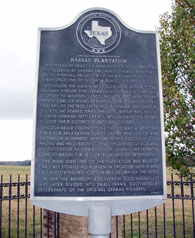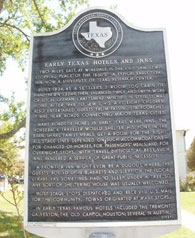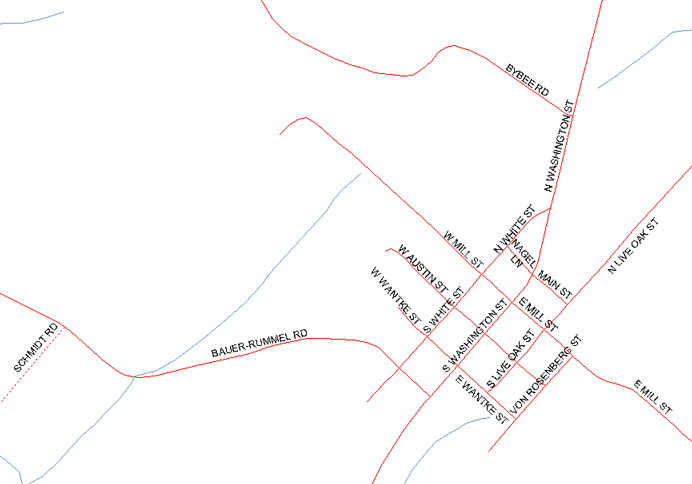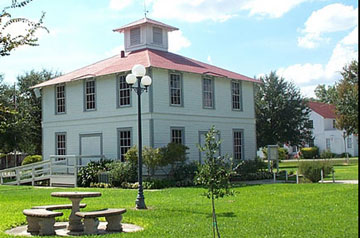 |
Round Top
Public Square, Washington Street
On the Old San Felipe Trail, in memory of John C. Robison, participant of the Battle of Velasco; Joel W. Robison, McHenry Winburn, Isaac Lafayette Hill, Spencer Burton Townsend, Stephen Townsend, Veterans of San Jacinto; J. T. Townsend, John P. Townsend of the San Jacinto Campaign; Mayers Fisher Jones of the Santa Fe and Snively Expeditions; John Rufus Alexander of the Mier Expedition, and other Pioneers who resided in the vicinity. — 1936
Round Top Community
Home of the Townsends, Hills and McH. Winburn, veterans of San Jacinto; Joel W. Robison, one of Santa Anna's captors; John Rice Jones, first postmaster general, Republic of Texas; and John C.C. Hill, boy captive of Mier Expedition and adopted by General Santa Anna. A center of German culture and crafts of 19th century. Examples: Nassau Plantation; Art of Mathias and Rudolph Melchior; Rev. Adam Neuthard's School; Stone Masonry of Carl S. Bauer; Lutheran Church with Wantke's handmade organ; and S. K. Lewis Stage Coach Inn. — 1996
|
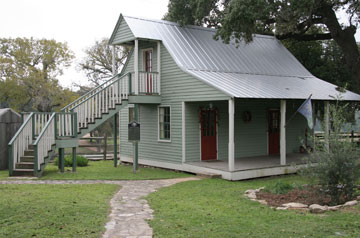 |
Schiege Cigar Factory
FM 237 (Washington Road)
By 1859 the U.S. was importing 900 million cigars yearly, mainly from Germany. Tariffs, levied on imported cigars beginning 1862, resulted in a dramatic increase in domestic cigar manufacturing. Tobacco was still an important cash crop when Charles Schiege, Jr., erected a one-room frame cigar factory here in 1882. The factory's roadside facade bore a sign reading "cigars & tobaccos." Factory workers made the cigars by hand and mainly from U.S. domestic tobaccos. Schiege marketed his cigars under a variety of labels, including "Texas Star," until 1932 when he closed the factory.
Sesquicentennial of Texas Statehood 1845-1995
|
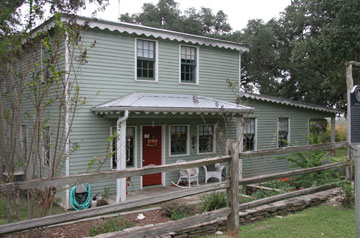 |
Schiege House
FM 237 (Washington Road)
Prussian immigrants Carl Johann Rudolph (Charles Henry) (b. 1815) and Caroline (Schubert) Schiege acquired land here in 1861. Only one of their four children, Charles Henry, Jr., (1858-1935), survived to adulthood. Charles Henry, Jr., built a 2-story home at this site abut 1885, the year he married Emma Frenzel. Emma died in 1892. In 1893 Schiege married Marie Becker; together they reared ten children. Charles and Marie Schiege are buried in nearby Florida Chapel Cemetery.
Sesquicentennial of Texas Statehood 1845-1995.
|
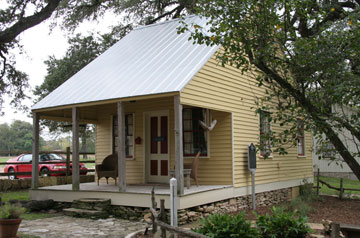 |
Schiege Cigar Factory Manager's House
FM 237 (Washington Road)
Charles Schiege employed mainly single men to manufacture cigars in his factory. The workers were provided with sleeping quarters in the attic area of the factory building. The factory manager, however, was often a family man, and to house these employees Schiege built a cottage of German vernacular design at this site about the time the factory was opened in 1882. Early cigar factory manager Paul Herman Helmecke (1864-1894) and his wife Martha Mary Neuthard, daughter of prominent local Pastor Adam Neuthard, lived here with their five children in the 1880s and 1890s.
Sesquicentennial of Texas Statehood 1845-1995
|
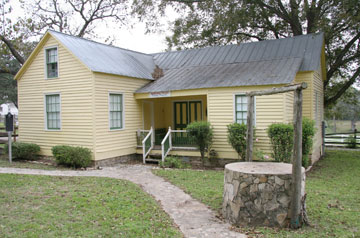 |
Pochmann House
Intersection of 2nd Street (Bauer-Rummel Road) and Washington Street (FM 237)
German immigrant Zoellistin (Cellestin) Pochmann (1835-1862) came to Texas about 1856-57. He worked as a cabinetmaker in La Grange and married Karoline Wandke (1837-1910) in 1857. They moved to a 3-room house about three miles northwest of here in 1860. After making improvements to the house they relocated the structure to this site about 1861. Zoellistin died from a snakebite in 1862. His son, Heinrich (Hy) Pochmann (1860-1926) also became a skilled cabinetmaker and served as mayor of Round Top for four years. Heinrich and Clara (Ebner) Pochmann reared their four sons here.
Sesquicentennial of Texas Statehood 1845-1995.
|
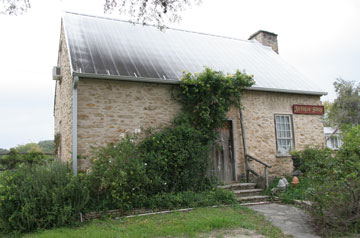 |
Wandke House
Corner of 2nd Street (Bauer- Rummel Street) and White Street
Johann Traugott Wandke (1808-1870) immigrated from Prussia to nearby La Grange with his wife Christiane and two daughters, Karoline and Christiane, in 1855. About 1860 Johann and Christiane came to Round Top to live in the home of their daughter Karoline and her husband Zoellistin Pochmann. They built their own native stone home/workshop at this site about 1863. Johann was a skilled mechanic and cabinetmaker but is best known for the high-quality organs he crafted from native cedar for several churches in the area including Round Top's Bethlehem Lutheran Church.
Sesquicentennial of Texas Statehood 1845-1995
|
 |
Bernard Scherrer
At Scherrer cabin in Henkel Square, corner of North Live Oak & Main Street
(1807 -1892) Bernard Scherrer left his native Switzerland at the age of 22 for extended travels before reaching Texas in 1833. After serving in Burleson's regiment during the Texas Revolution, he received a land grant in Colorado County but settled in Biegel settlement (Fayette County) about 1838. Here he served as justice of the peace, county commissioner, and in 1845 he married Gesine Eliza Margarete Koch. He left his civic, farming and freighting duties to serve in the Confederate Army during the Civil War. This cabin, Scherrer's first residence in Texas, was moved to this location in 1975. [marker erected in 1992]
|
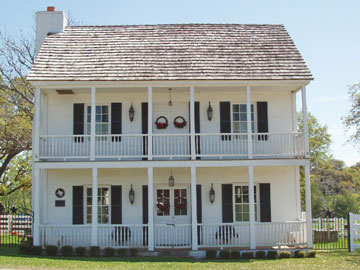 |
Schueddemagen Home
Hwy 237 at Rock Street, Round Top
This home, built in 1852 by Carl Siegismunde Bauer, is of Teutonic architecture, a replica of the family home in Wiesa, Kingdom of Saxony. Built for his daughter and her husband, Wilhelmine and Conrad Schueddemagen (later changed to Shudde).
Recorded Texas Historic Landmark - 1964
|
|
|
Konrad Joh Log Cabin
South of Round Top on Hartfield Road, one mile west of FM 237
According to tradition, this cabin was erected about 1848 near the main Galveston to Bastrop Rd. The hand-hewn live oak logs were chinked with a mixture of mud, straw, and sand. Konrad (1830-1912) and Elisa (Zwernemann) Joh (1839-1901), who migrated to Texas from Germany, occupied the structure for many years. In 1875 they used oxen to move the cabin about 300 feet uphill from its original location. Later members of the Paetzold family lived here.
Recorded Texas Historic Landmark - 1987
|
 |
The Menn House
FM 1457, Round Top.
Built near Winedale (4.5 Miles NE), probably by landowner Samuel K. Lewis (1807-67), ex-congressman, Texas Republic. Occupied 1860s by William and Carolina Menn and their 12 children, bought 1880 by Menn, this was home of their descendants until 1931.
Recorded Texas Historic Landmark - 1973
|
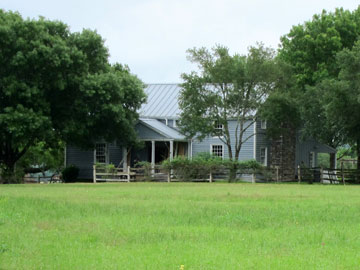 |
Hamilton Ledbetter House
229 Hackemack Road
North Carolina native Hamilton Ledbetter (1808-1888) and his wife Jane Amanda ( Peacock) (1813-1884) settled in Victoria County in 1839. Ledbetter moved to Fayette County in 1845. Soon he built this home for his large family. Ledbetter's plantation was the location of Round Top Academy which operated 1854-67. A prominent citizen, he served as Round Top marshall and State Senator, 1872-74. The house was moved about one mile to this site in 1959. Recorded Texas Historic Landmark - 1979. |
|
|
Nassau Plantation
from Round Top, take FM 1459 N 2.7 mile to junction of FM 1457 & Wolff Rd.
An extensive tract of land purchased in 1843 for colonization by German emigrants. Named for Duke Adolf of Nassau, protector of the emigration society, it was once one of the show places of Texas.
Although the 4,428 acres could have been a good half-way station for German colonists on the long journey to western lands, this use was rejected by Prince Carl of Solms-Braunfels, the commissioner general of the "Adelsverein", or German Emigration Society. He feared that the site, which was close to non-German settlements, would cause his people to lose their distinctive national culture.
Though never colonized, Nassau became a welcome place for relaxation during trying periods of the emigration movement. Here the prince enjoyed horse racing and held feasts costing thousands of dollars. His successor as commissioner, John O. Meusebach, came to Nassau for less extravagant entertainment.
The main dwelling on the plantation was built of oak, two stories high. Even in frontier days it had two glass windows. Cotton was grown on the lands.
In 1848 the bankrupt Adelsverein sold Nassau. It was later divided into small farms, cultivated by descendants of the original German pioneers. — 1968
|
|
|
Early Texas Hotels and Inns
Marker located on Round Top town square on Washington Street
Two miles east, at Winedale, is the Old "Sam Lewis Stopping Place" of the 1850s — a typical early Texas inn, now a University of Texas Research Center. Built 1834, as a settler's 2-room log cabin of hand-hewn cedar; then enlarged twice and (with work of local German craftsmen) improved in style, it was home after 1848 to Lewis, his wife, eight children; also entertained guests from passing stagecoaches. It was near roads connecting major Texas cities. Many roadside homes in early Texas were inns. The horseback traveler would shelter his pony in the barn, share family meals, get a room for the night. All stage lines depended on such accommodations-- for changes of horses, for passengers' meals, and for overnight stops. With travel difficult at best, such inns rendered a service of great public necessity. A frontier inn might even be a dugout, where the guests rolled up in blankets and slept on the floor. (Travelers sometimes had to sleep under a tree, so any sort of sheltering house was usually welcomed.) Most stage stops dispatched and received U.S. mail for the community. Towns originated at many stops. In early Texas, famous hotels included the Tremont, Galveston;The Old Capitol, Houston; several in Austin. —1967
|
| |
Rocky Creek Farm
from Round Top, take County Road 102 SE about 1.6 miles (on E. side of rd.)
Original one-story house was built about 1854 for settler James Wade; situated then on the former Nassau Farm, a vast tract intended for settlement by German immigrants. Count Boos-Waldeck, an agent for the Adelsverein (German Emigration Society), purchased the land but another area was colonized instead. In 1894 Rudolph Weigelt of Germany bought the farm and in 1913 erected present house, which encloses the original one. Recorded Texas Historic Landmark — 1970. |
| |
Ludwig and Caroline Giese House
11103 S Nassau Road
Ludwig and Caroline Giese House German immigrant Ludwig Giese arrived in Galveston in 1850 and made his way to Fayette County, where he became a teamster and farmer. Following service in the Confederacy during the Civil War, he settled in the Haw Creek community, where in the 1870s he purchased a farmstead that included this house. The German Vernacular structure features stone piers, a full-length front porch and an infilled dogtrot. Ludwig and his wife, Caroline (Naeglie), reared ten children here, and the house was still in the Giese family at the turn of the 21st century. Recorded Texas Historic Landmark - 2002 |
| Bethlehem Lutheran Church
Isaac Lafayette Hill
Samuel Knight Lewis
|
|
men to the battle of San Jacinto than any other family. Joel Robinson, another Round Top resident, was the captor of Antonio López de Santa Anna. His father, John Robinson, was a member of the First Congress of Texas. John Rice Jones, Jr., settled in the Round Top area in 1831 and in 1835 was made the first postmaster general of Texas by the provisional government. Other important names associated with the earliest settlers were Taylor, Ledbetter, and Alexander. The Ledbetter land was the site of the first Round Top Academy. By the mid-1830s Round Top was identified as Jones Post Office. The English were soon supplemented by Germans. In the early 1840s Alwin H. Soergel, author, historian, musician, and member of the Adelsverein, settled in the Round Top area, bringing with him the beginnings of the Germanic traditions that characterize the area. He built a white house with an octagonal tower, which by 1847 was listed as the United States post office, with Henry A. Robertson as postmaster. The odd-shaped tower gave rise to the name Round Top. By 1850 Round Top had a population of 150, two stores, two blacksmith shops, two taverns, a post office, and a line of tri-weekly stages serving the predominantly German citizenry. According to some sources the first Round Top Fourth of July celebration, held in 1851, gave the community the distinction of having the oldest continuous Independence Day celebration west of the Mississippi. During the Civil War Round Top served as a recruiting station for the northern half of the county.
In 1866 Rev. Adam Neuthard organized a Lutheran congregation; the massive old stone church completed in 1867 remained in use in 1991, along with its pipe organ, carved by Traugott Wantke out of native cedar. Education, music, language studies, and the arts played an important role in the lives of residents, and the cultural arts characterized Round Top throughout the nineteenth century. Reverend Neuthard, who founded the Neuthard School at Round Top in 1858, was a master of Hebrew, Greek, Latin, French, and German. Clara Rummel, the "poetess of Texas," made her home in Round Top, and the town boasted about its string band. Round Top was incorporated in 1870. In 1884 the town had a population of 200, which increased to 360 by 1900 but decreased to 150 by 1925 and continued to decline slowly throughout the 1900s. During the twentieth century John G. Banik of Round Top became a celebrated orator, poet, and historian. The artist James Donald Painter depicted Round Top scenes, as Mathias Melchior and his three sons had done as early as 1854. Don Nagel served Round Top as mayor for thirty-one years. Major restorations were accomplished by the Bybee Foundation on Henkel Square, by the James Dick Foundation on Festival Hill, and by Miss Ima Hogg at Winedale. Round Top has become an internationally recognized cultural center for the arts and education through the programs of the International Festival-Institute, founded in 1971. The 1,200-seat concert hall at Festival Hill is the permanent home of the Texas Festival Orchestra. In 1990 Round Top had a population of eighty-one.











